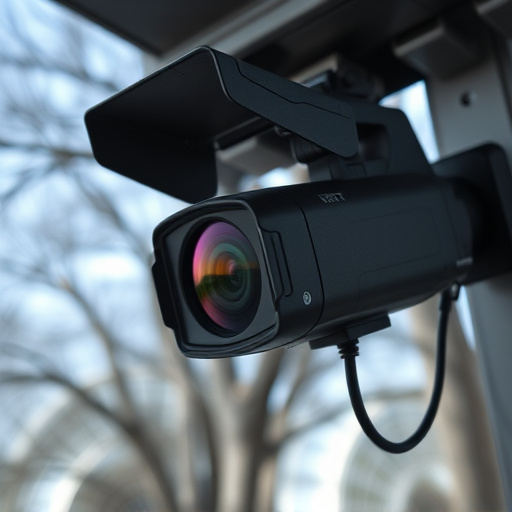Nighttime security footage challenges include glints from bright sources, distorting data and impacting surveillance accuracy. Modern camera technologies use algorithms, specialized lenses, and image processing to overcome these issues, crucial for Discrete Security Cameras for Renters. Advanced infrared cameras capture clear images in low-light conditions, enhancing property monitoring without sacrificing privacy. Innovative deep learning models reduce false alarms and improve detection efficiency. Strategically selecting lenses, adjusting camera settings, and optimal placement significantly enhance nighttime surveillance effectiveness for renters.
In the realm of security surveillance, especially in low-light conditions, understanding night-time glint is crucial. This article explores the intricacies of lens glint detection during nighttime, addressing challenges faced by traditional methods. We delve into discrete camera solutions tailored for tenants and landlords, while highlighting innovative techniques for accurate glint identification. Additionally, a step-by-step guide on optimizing night vision enhances the overall effectiveness of security systems, particularly for those utilizing discreet security cameras for renters.
- Understanding Night-Time Glint in Security Footage
- Challenges of Traditional Lens Glint Detection
- Discrete Camera Solutions for Tenants and Landlords
- Innovative Techniques for Glint Identification
- Optimizing Night Vision: A Step-by-Step Guide
Understanding Night-Time Glint in Security Footage
Nighttime is often when security footage reveals its most striking and insightful details, but it also presents unique challenges, particularly in detecting glints. Glints—those fleeting reflections from bright objects like car headlights or windows—can obscure important visual information, making them a nuisance for security camera systems, especially in low-light conditions. For renters considering discrete security cameras, understanding this phenomenon is key to ensuring effective monitoring.
In the realm of night-time surveillance, these glints can mimic movement, create false positives, or entirely hide objects of interest, leading to missed incidents. This is where advanced camera technologies step in. Modern security systems employ sophisticated algorithms to mitigate the impact of glints, enhancing the overall quality and accuracy of footage. By utilizing specialized lenses and image processing techniques, discrete security cameras for renters can now capture clear images even under intense nighttime lighting conditions.
Challenges of Traditional Lens Glint Detection
The traditional method of lens glint detection in security cameras often faces several challenges, especially in low-light conditions or complex environments. One significant issue is the difficulty in distinguishing between genuine glints and other reflective surfaces, such as shiny objects or wet roads. This can lead to false alarms or, conversely, missed detections, impacting the overall accuracy of the system.
Additionally, most conventional techniques rely on intensive computational resources, making them less suitable for discrete security cameras commonly used by renters or small businesses. These devices often have limited processing power and storage, hindering the implementation of complex algorithms required for effective glint detection. Therefore, a streamlined and efficient approach is necessary to enhance the reliability and practicality of lens glint detection in these scenarios.
Discrete Camera Solutions for Tenants and Landlords
For tenants and landlords looking to enhance their security measures, particularly in low-light conditions, discrete camera solutions offer a discreet yet effective approach. These advanced systems are designed to capture clear images during night operations, ensuring every corner of a property is monitored without compromising privacy or aesthetics.
Discrete security cameras for renters provide an added layer of protection for both parties. Tenants can ensure their safety and the security of their belongings, while landlords gain peace of mind knowing their properties are well-guarded. This technology leverages infrared lighting and high-resolution sensors to capture detailed footage even in complete darkness, making it a versatile tool for any rental setup.
Innovative Techniques for Glint Identification
In the realm of enhancing night-time surveillance, the discrete security cameras for renters have embraced innovative techniques to tackle a common challenge—glint detection. Traditional methods often rely on brute force, consuming significant computational resources. However, advanced algorithms are now being developed to identify glints more accurately and efficiently. These algorithms leverage deep learning models, trained on vast datasets of various lighting conditions and environmental factors, to distinguish between genuine security threats and innocuous reflections.
By employing these sophisticated techniques, discrete security cameras can significantly reduce false alarms while enhancing overall surveillance quality. The result is a smarter, more responsive security system tailored for renters who seek both peace of mind and cost-effective solutions. This evolution in glint identification not only improves the effectiveness of security measures but also contributes to a safer living environment.
Optimizing Night Vision: A Step-by-Step Guide
Optimizing night vision with discrete security cameras for renters involves a step-by-step approach to ensure effective surveillance in low-light conditions. First, selecting the right camera lens is crucial. Look for lenses designed with advanced coatings that reflect ambient light, enhancing darkness visibility. These coated lenses minimize glare and glint, allowing the camera to capture clearer images during nighttime.
Next, adjusting camera settings is essential. Enable night vision modes or infrared capabilities to boost low-light performance. Lower ISO sensitivity can reduce noise in images while increasing exposure time improves image clarity. Additionally, ensuring proper placement of the camera—high up and away from direct light sources—can significantly minimize glint and enhance overall nighttime surveillance.
In conclusion, navigating the challenges of night-time glint in security footage has evolved with innovative techniques and discrete camera solutions. For tenants and landlords seeking enhanced surveillance, understanding these methods is key. By optimizing night vision through advanced steps and embracing cutting-edge technologies, such as discreet security cameras for renters, individuals can now achieve clearer, more reliable footage. This ensures better protection and peace of mind in even the darkest environments.
